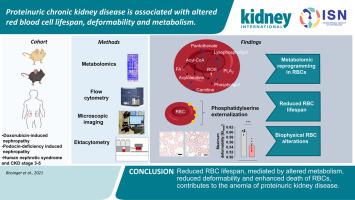Kidney International ( IF 14.8 ) Pub Date : 2021-09-16 , DOI: 10.1016/j.kint.2021.08.024 Rosi Bissinger 1 , Travis Nemkov 2 , Angelo D'Alessandro 3 , Marijke Grau 4 , Thomas Dietz 4 , Bernhard N Bohnert 5 , Daniel Essigke 1 , Matthias Wörn 1 , Lina Schaefer 1 , Mengyun Xiao 1 , Jonathan M Beirne 2 , M Zaher Kalo 1 , Anja Schork 5 , Tamam Bakchoul 6 , Kingsley Omage 1 , Lingsi Kong 1 , Irene Gonzalez-Menendez 7 , Leticia Quintanilla-Martinez 7 , Birgit Fehrenbacher 8 , Martin Schaller 8 , Achal Dhariwal 9 , Andreas L Birkenfeld 5 , Florian Grahammer 10 , Syed M Qadri 11 , Ferruh Artunc 5

|
Anemia is a common complication of chronic kidney disease, affecting the quality of life of patients. Among various factors, such as iron and erythropoietin deficiency, reduced red blood cell (RBC) lifespan has been implicated in the pathogenesis of anemia. However, mechanistic data on in vivo RBC dysfunction in kidney disease are lacking. Herein, we describe the development of chronic kidney disease-associated anemia in mice with proteinuric kidney disease resulting from either administration of doxorubicin or an inducible podocin deficiency. In both experimental models, anemia manifested at day 10 and progressed at day 30 despite increased circulating erythropoietin levels and erythropoiesis in the bone marrow and spleen. Circulating RBCs in both mouse models displayed altered morphology and diminished osmotic-sensitive deformability together with increased phosphatidylserine externalization on the outer plasma membrane, a hallmark of RBC death. Fluorescence-labelling of RBCs at day 20 of mice with doxorubicin-induced kidney disease revealed premature clearance from the circulation. Metabolomic analyses of RBCs from both mouse models demonstrated temporal changes in redox recycling pathways and Lands’ cycle, a membrane lipid remodeling process. Anemic patients with proteinuric kidney disease had an increased proportion of circulating phosphatidylserine-positive RBCs. Thus, our observations suggest that reduced RBC lifespan, mediated by altered RBC metabolism, reduced RBC deformability, and enhanced cell death contribute to the development of anemia in proteinuric kidney disease.
中文翻译:

蛋白尿性慢性肾病与红细胞寿命、变形能力和新陈代谢的改变有关
贫血是慢性肾脏病的常见并发症,影响患者的生活质量。在各种因素中,例如铁和促红细胞生成素缺乏,红细胞 (RBC) 寿命缩短与贫血的发病机制有关。然而,体内的机械数据肾病中缺乏红细胞功能障碍。在此,我们描述了因服用多柔比星或诱导型 podocin 缺乏而导致蛋白尿肾病小鼠发生慢性肾病相关性贫血的情况。在这两个实验模型中,尽管循环促红细胞生成素水平和骨髓和脾脏中的红细胞生成增加,但贫血在第 10 天出现并在第 30 天出现进展。两种小鼠模型中的循环红细胞都显示出形态学改变和渗透敏感变形能力降低,同时外质膜上的磷脂酰丝氨酸外化增加,这是红细胞死亡的标志。在多柔比星诱导的肾脏疾病小鼠第 20 天,RBC 的荧光标记显示循环中的过早清除。来自两种小鼠模型的红细胞的代谢组学分析表明氧化还原循环途径和兰德循环的时间变化,这是一种膜脂重塑过程。患有蛋白尿性肾病的贫血患者的循环磷脂酰丝氨酸阳性红细胞比例增加。因此,我们的观察表明,由改变的红细胞代谢介导的红细胞寿命缩短、红细胞变形能力降低和细胞死亡增加有助于蛋白尿肾病中贫血的发展。











































 京公网安备 11010802027423号
京公网安备 11010802027423号